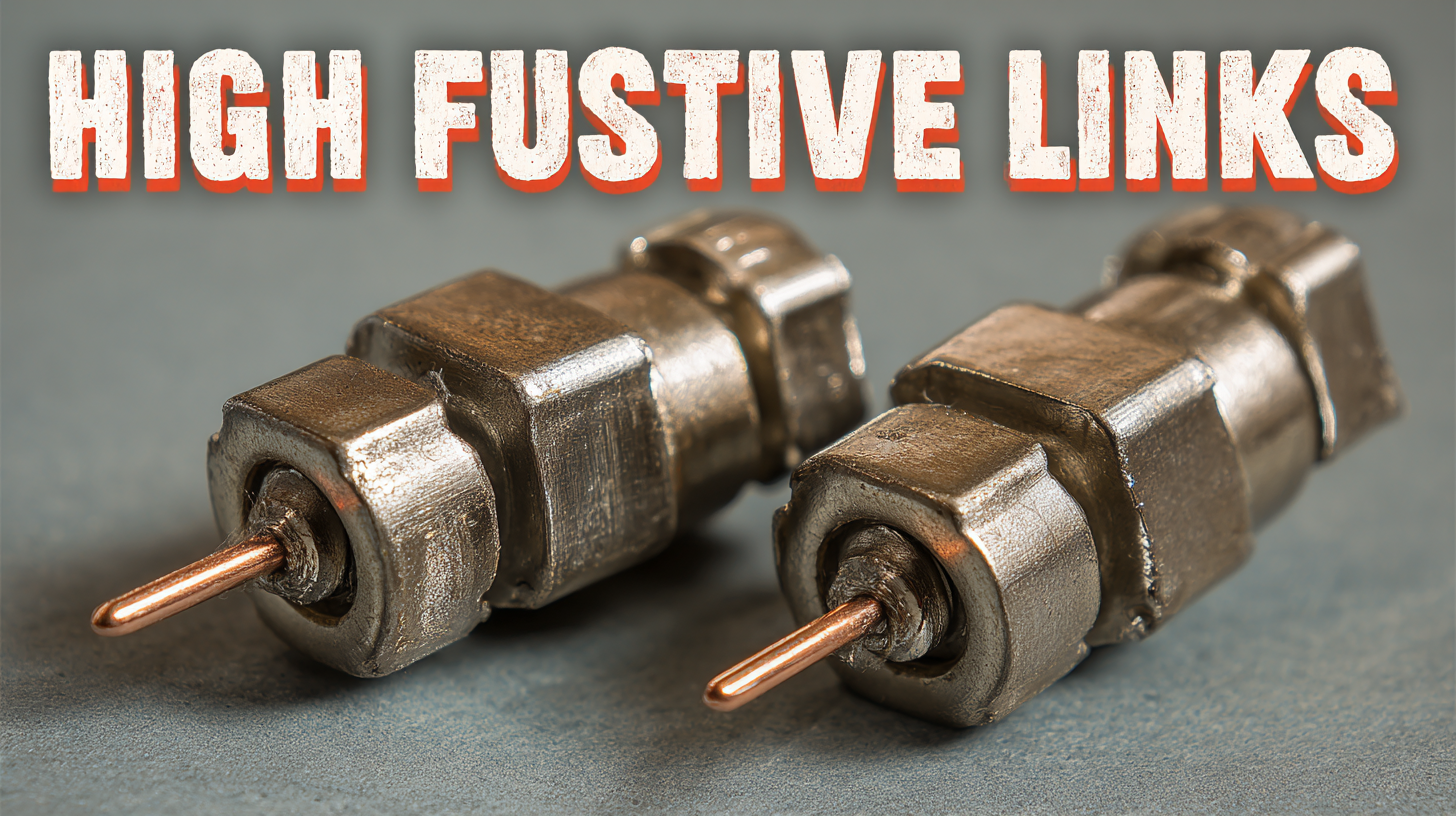
-
Home
-
About Us
-
Products
-
News
-
Blog
-
Contact Us
Leave Your Message

In the rapidly evolving landscape of electrical engineering, High Voltage Fuse Links have emerged as a critical component for ensuring safety and efficiency in power systems. According to a report by MarketsandMarkets, the high voltage fuse market is projected to reach $1.28 billion by 2025, growing at a significant CAGR of 5.2% due to increased demand for reliable electrical infrastructure across various industries. As businesses look to enhance their operational resilience, understanding the best practices for High Voltage Fuse Links becomes paramount. This blog will delve into seven essential facts that every business should be aware of, aligning with the overarching technological trends and strategies shaping the industry toward 2025. By integrating cutting-edge solutions and strategic insights, organizations can safeguard their electrical systems and remain competitive in a dynamic market environment.

When it comes to high voltage fuse links, understanding their key characteristics is crucial for any business relying on electrical systems.
First and foremost, the breaking capacity of a fuse link must be compatible with the fault levels of your application. A high breaking capacity ensures that in the event of a fault, the fuse will effectively interrupt the current flow without sustaining damage, protecting both equipment and personnel.
Another important characteristic is the time-current characteristic, which defines how quickly a fuse reacts to overcurrent conditions.
Fast-acting fuse links provide rapid protection against short circuits, while delayed fuses can tolerate temporary overloads, making them suitable for equipment with high inrush currents.
Additionally, temperature rating plays a significant role in performance; it's essential to choose fuse links rated for the environment they will be placed in to avoid premature failure.
By prioritizing these attributes, businesses can enhance safety and reliability in their electrical systems.
High voltage fuse links play a critical role in protecting electrical systems from overcurrent and equipment damage. When selecting the best options for your business, it's essential to understand the different types of high voltage fuse links available. These devices come in various designs and ratings, each tailored to specific applications and operational demands. The most common types include cylindrical fuses, which are often used in industrial setups, and modular fuses, typically found in renewable energy systems like solar panels.
Another important category is the current-limiting fuse, which is designed to reduce the impact of short circuits by interrupting the current flow quickly, thereby minimizing equipment stress and potential downtime. When choosing a high voltage fuse link, businesses should also consider factors such as voltage ratings, fusible element materials, and the environment in which the fuse will operate. By understanding these distinctions, companies can select the right fuse links to ensure safety, reliability, and optimal performance in their electrical systems.
| Type of Fuse Link | Voltage Rating (kV) | Current Rating (A) | Breaking Capacity (kA) | Application |
|---|---|---|---|---|
| Expulsion Fuse | 15 | 200 | 25 | Overhead Distribution |
| Current Limiting Fuse | 27 | 600 | 50 | Substation Protection |
| Dual Element Fuse | 33 | 400 | 30 | Motor Protection |
| Class L Fuse | 36 | 2000 | 100 | Industrial Equipment |
| General Purpose Fuse | 15 | 600 | 20 | General Applications |
| Low Voltage Fuse | 1 | 100 | 10 | Residential Use |
| Vacuum Fuse | 27 | 3000 | 80 | Heavy Industry |
High voltage fuse links are vital components in ensuring electrical safety in industrial settings. These fuses act as protective devices that interrupt the electrical flow during fault conditions, thus preventing potential damage to electrical equipment and minimizing safety risks. According to a report by MarketsandMarkets, the global demand for fuse links is projected to grow significantly, fueled by the increased focus on safety regulations and standards across various industries. Incorporating high voltage fuse links not only enhances operational reliability but also adheres to safety compliance, which is crucial for any business dealing with electricity.
Tip: When selecting fuse links, always consider the voltage ratings and interrupting capacity. Matching these parameters to your system's requirements is essential for optimal protection. It is also advisable to periodically test and replace fuse links to maintain their efficiency and reliability.
Moreover, high voltage fuse links can significantly reduce downtime and repair costs associated with electrical failures. A study highlighted in an IEEE publication emphasizes that businesses equipped with proper fuse link systems experience up to 30% fewer equipment failures. This reliability translates to improved productivity and lower maintenance expenses.
Tip: Conduct regular training for your staff on the proper handling of high voltage equipment and the importance of fuse link maintenance to further bolster electrical safety within your organization. Ensuring that your team is knowledgeable can prevent mishandling and facilitate quicker responses during emergencies.

High voltage fuse links play a critical role in enhancing energy efficiency in various business operations. By providing robust protection against overcurrent, these specialized devices ensure that electrical systems remain safe and functional, allowing for continuous, uninterrupted energy flow. This unbroken supply not only maximizes productivity but also reduces the risk of energy wastage due to system failures. When designed effectively, high voltage fuse links can minimize downtime, leading to significant cost savings and improved operational efficiency.
Moreover, the integration of high voltage fuse links into energy management systems can lead to smarter energy consumption patterns. Unlike traditional fuses, modern high voltage fuse links are often equipped with advanced monitoring capabilities that allow businesses to track and analyze their energy usage in real-time. This data can inform strategic decisions on energy management, helping organizations to identify areas where they can cut costs and reduce their carbon footprint. By optimizing energy usage through the adoption of these fuse links, businesses not only enhance their operational efficiency but also contribute to broader sustainability goals, making high voltage fuse links an essential component of contemporary energy strategies.

High voltage fuse links are crucial components in ensuring the safety and reliability of electrical systems in various industries. To maximize their lifespan, regular maintenance and adherence to best practices are essential. According to a report by the Institute of Electrical and Electronics Engineers (IEEE), improper maintenance can reduce the operational life of fuse links by up to 30%. Therefore, implementing routine inspections and testing can significantly enhance their longevity and performance.
One effective maintenance tip is to regularly check for signs of overheating, which can indicate overcurrent or poor connections. The National Electrical Manufacturers Association (NEMA) recommends thermal imaging as a proactive measure to detect issues before they lead to system failures. Additionally, it is vital to ensure that fuse links are installed correctly, as improper installation can not only shorten their lifespan but also pose serious safety risks. Regularly updating and following manufacturer guidelines, along with training staff on proper handling and maintenance procedures, can contribute to the reliable operation of high voltage fuse links.
This chart illustrates the importance of various factors to consider when selecting high voltage fuse links for your business. Ratings range from 1 to 10, with higher numbers indicating greater importance. Understanding these factors can help maximize the lifespan of fuse links in your electrical systems.